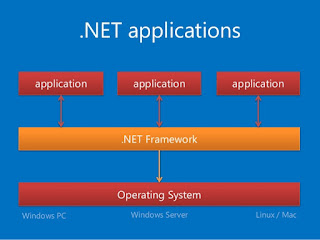The .NET Framework ("dot net") is a platform created by Microsoft used to develop completely different types of applications targeted in the main to the Windows OS. The .NET Framework may also be used for developing net applications. many versions of the .NET are free within the past and every iteration adds extensive quantity of options to the sooner version. Although .NET applications area unit designed for Windows, some third-party corporations try and port the .NET to alternative systems. The .NET Framework contains the .NET Framework Category Library (FCL) that may be a large library of categories, structs, enumerations, basic sorts, and plenty of additional that area unit classified into completely different modules or assemblies.
Common Language Runtime (CLR) is that the core of .NET that runs .NET applications. It allows the .NET framework to grasp variety of supported languages like C#, Visual Basic, and C++. The code that runs below the CLR and .NET is named managed code because the CLR manages completely different aspects of your application throughout runtime.
During compilation, source codes are compiled into Common Intermediate Language (CIL) that is closely identical to assembly language. We've got to convert our source code into CIL as a result of it's the sole language which will be understood by .NET. as an example, codes in C# and Visual Basic each compile to CIL. that's why completely different .NET applications written in numerous languages will still communicate to every alternative. If you would like a language to be .NET-compatible, you'll be able to produce a compiler that compiles your code into the Intermediate Language. The compiled CIL is hold on in associate assembly like a .exe or .dll file.
Once your code is compiled to Common Intermediate Language, the duty is transfered to the Just-In-Time (JIT) compiler. The JIT compiles the CIL code into native code(the language of computers) only if that a part of code is required by the program (hence the term "just in time"). The compiled native code is mechanically optimized for the present OS or machine. this is often one advantage of mistreatment .NET.
The following summarizes however your C# code is reworked into a machine viable program.
Garbage collection is another feature of the .NET Framework. once resources aren't any longer in use, .NET Framework frees up the memory utilized by associate application. the rubbish collector decisioned|is named|is termed} whenever it's required by associate application though you'll be able to call gigahertz manually to wash up resources for you.
To be ready to run a .NET application, you want to 1st install it in your pc. Latest unharness of Windows seven package has .NET pre-installed. If your system does not have .NET put in nevertheless, you'll be able to transfer it by clicking the link below:
Microsoft .NET 4.0 Download
After downloading, run the installer and follow the directions. you may got to restart the pc after/during installation.
(.NET four also will be put in if you put in Visual C# categorical or Visual Studio 2010 as we'll see later).
Common Language Runtime (CLR) is that the core of .NET that runs .NET applications. It allows the .NET framework to grasp variety of supported languages like C#, Visual Basic, and C++. The code that runs below the CLR and .NET is named managed code because the CLR manages completely different aspects of your application throughout runtime.
During compilation, source codes are compiled into Common Intermediate Language (CIL) that is closely identical to assembly language. We've got to convert our source code into CIL as a result of it's the sole language which will be understood by .NET. as an example, codes in C# and Visual Basic each compile to CIL. that's why completely different .NET applications written in numerous languages will still communicate to every alternative. If you would like a language to be .NET-compatible, you'll be able to produce a compiler that compiles your code into the Intermediate Language. The compiled CIL is hold on in associate assembly like a .exe or .dll file.
Once your code is compiled to Common Intermediate Language, the duty is transfered to the Just-In-Time (JIT) compiler. The JIT compiles the CIL code into native code(the language of computers) only if that a part of code is required by the program (hence the term "just in time"). The compiled native code is mechanically optimized for the present OS or machine. this is often one advantage of mistreatment .NET.
The following summarizes however your C# code is reworked into a machine viable program.
- The computer programmer writes a program during a .NET compatible language like C#.
- The C# code is compiled into its CIL equivalent code.
- The CIL is hold on in associate assembly.
- When the code is executed, the JIT compiles the CIL code to native code that the pc can execute.
Garbage collection is another feature of the .NET Framework. once resources aren't any longer in use, .NET Framework frees up the memory utilized by associate application. the rubbish collector decisioned|is named|is termed} whenever it's required by associate application though you'll be able to call gigahertz manually to wash up resources for you.
To be ready to run a .NET application, you want to 1st install it in your pc. Latest unharness of Windows seven package has .NET pre-installed. If your system does not have .NET put in nevertheless, you'll be able to transfer it by clicking the link below:
After downloading, run the installer and follow the directions. you may got to restart the pc after/during installation.
(.NET four also will be put in if you put in Visual C# categorical or Visual Studio 2010 as we'll see later).





